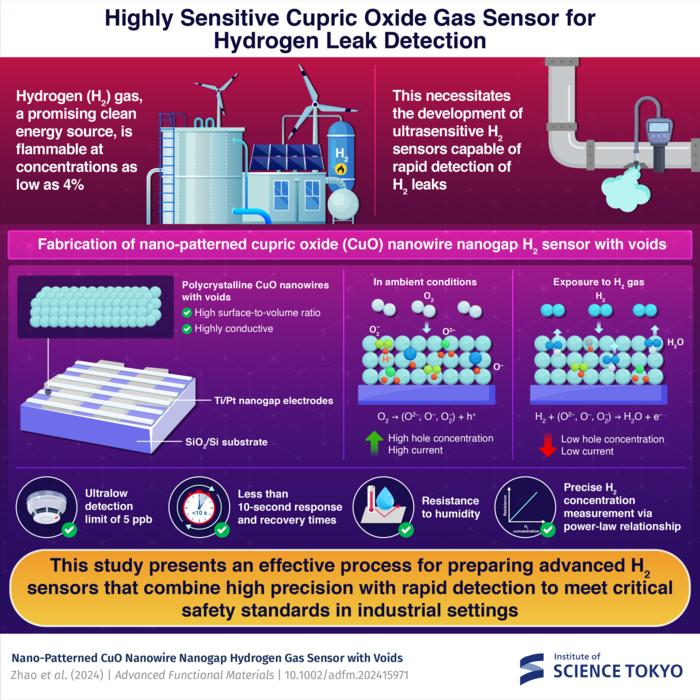As the global energy landscape shifts towards cleaner alternatives, hydrogen is emerging as a favored choice. Its appeal lies in its ability to be burned like traditional fuels while producing only water as a byproduct, and its capacity to generate electricity in fuel cells. However, the increased production, utilization, and transportation of hydrogen bring forth significant safety concerns.

This study presents an effective process for preparing advanced H2 sensors that combine high precision with rapid detection to meet critical safety standards in industrial settings. Image Credit: Science Tokyo
Hydrogen’s highly flammable nature at concentrations as low as 4 %, combined with its odorless and colorless properties, makes leak detection particularly challenging. To tackle these challenges, a research team led by Professor Yutaka Majima from the Institute of Science Tokyo has developed a cutting-edge sensor capable of detecting ultra-low hydrogen concentrations with exceptional speed.
The newly developed sensor leverages nano-patterned polycrystalline copper oxide (CuO) nanowires (NWs) mounted on a silicon dioxide/silicon substrate with platinum and titanium electrodes. These CuO NWs demonstrate high sensitivity to hydrogen gas.
We employed electron-beam lithography and two-step ex-situ oxidization to develop a reliable and reproducible process for preparing high-performance, nano-patterned CuO nanowire-nanogap hydrogen gas sensors with voids, which is considerably different from conventional free-standing single-crystal CuO nanowires directly grown from copper sources.
Yutaka Majima, Professor, Institute of Science Tokyo
The sensor’s mechanism involves changes in the electrical resistance of the CuO NWs when exposed to hydrogen gas.
In an oxygen-rich environment, oxygen molecules adhere to the CuO NWs’ surface, forming ions(O2⁻, O⁻, O22–) that create a layer of positive charge carriers, or holes, near the surface. When hydrogen gas interacts with these oxygen ions, water is formed, reducing the hole concentration and consequently increasing the resistance of the NWs. This measurable change in resistance enables the detection of hydrogen presence and concentration.
The researchers introduced a pre-annealing process in a hydrogen-rich atmosphere, followed by gradual oxidation in dry air, to significantly enhance the sensor's performance. Initially, the copper nanowires exhibited low crystallinity, with a Cu oxide layer limiting their interaction with oxygen. The annealing process reshaped the nanowires from a rectangular cross-section to a semicircular arch, improving their structural integrity. During the oxidation phase, copper atoms diffused outward to react with oxygen, forming voids that increased the surface area. This enhanced surface area provided more active sites for hydrogen and oxygen interactions.
Thanks to these advancements, the sensor demonstrated remarkable sensitivity, detecting hydrogen concentrations as low as 5 parts per billion (ppb)—a substantial improvement over previous CuO-based hydrogen sensors. Furthermore, it exhibited resistance to humidity, a common limitation of similar sensors. The sensor’s rapid detection capabilities were also notable, identifying hydrogen in just 7 seconds.
The research team further improved the sensor’s performance by minimizing the separation between the electrodes, reducing the nanogap to 33 nanometers. A smaller nanogap enhances the electric field strength, facilitating faster charge carrier movement. This modification allowed the sensor to detect hydrogen concentrations of 1000 parts per million (ppm) in just 5 seconds, with recovery to baseline levels achieved within 10 seconds.
“We will continue developing a wider range of gas sensors with this process to fabricate sensors for other hazardous gases as well,” Prof. Majima concluded.
By addressing critical safety concerns, this sensor technology supports the safe integration of hydrogen into energy systems, advancing the global transition towards a sustainable hydrogen-based economy.
Journal Reference:
Zhao, M. et. al. (2024) Nano-Patterned CuO Nanowire Nanogap Hydrogen Gas Sensor with Voids. Advanced Functional Materials. doi.org/10.1002/adfm.202415971